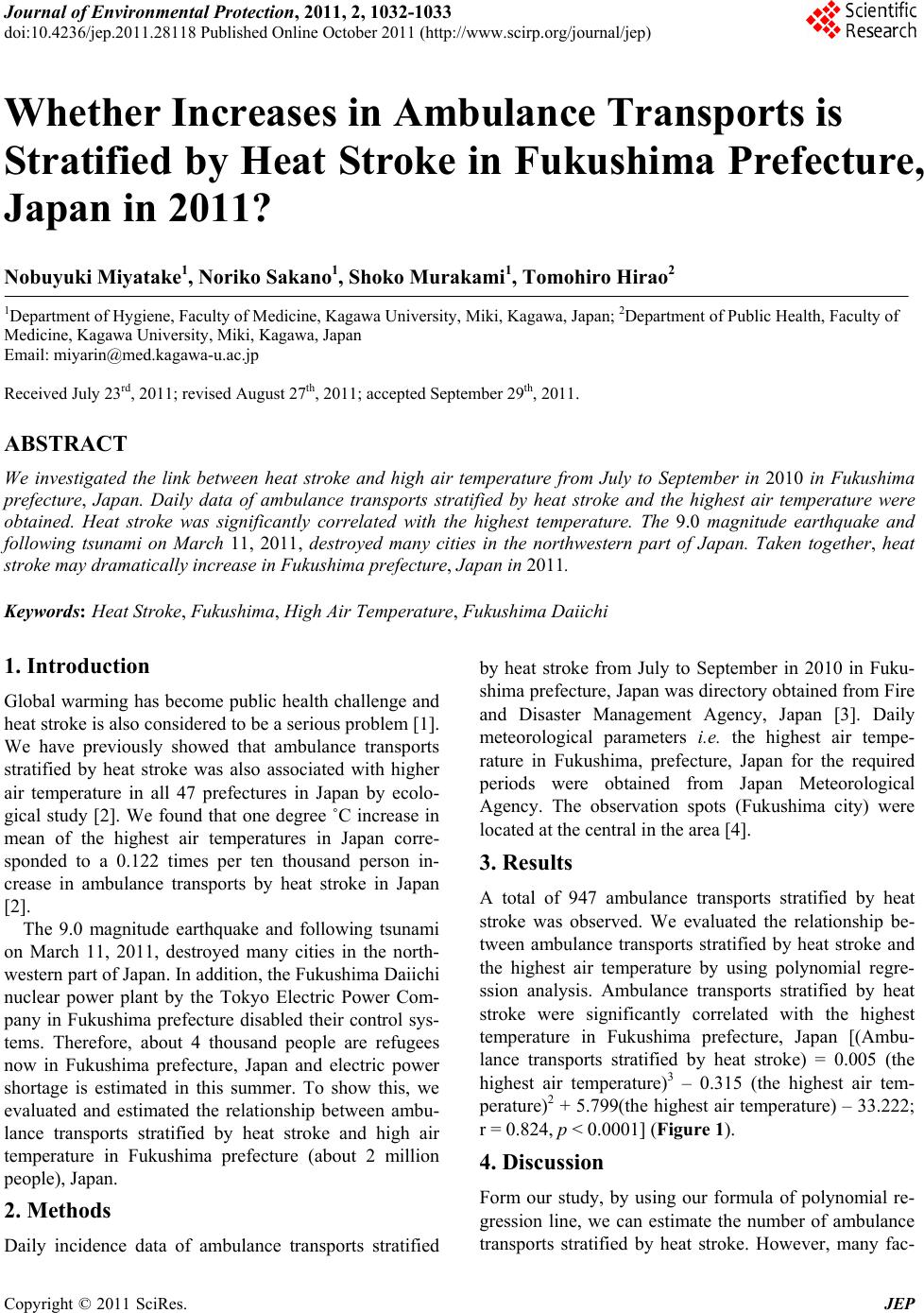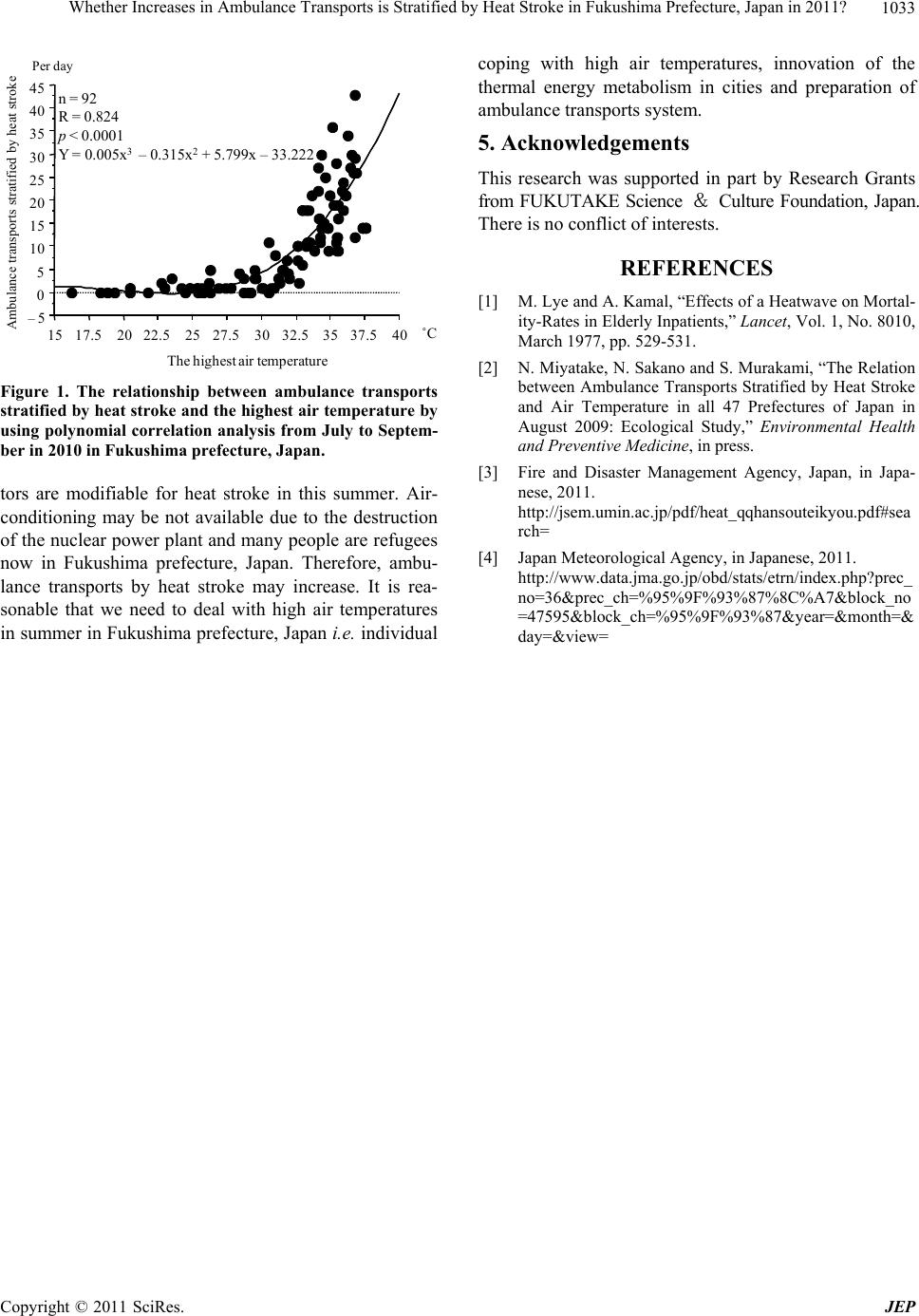Paper Menu >>
Journal Menu >>
 Journal of Environmental Protection, 2011, 2, 1032-1033 doi:10.4236/jep.2011.28118 Published Online October 2011 (http://www.scirp.org/journal/jep) Copyright © 2011 SciRes. JEP Whether Increases in Ambulance Transports is Stratified by Heat Stroke in Fukushima Prefecture, Japan in 2011? Nobuyuki Miyatake1, Noriko Sakano1, Shoko Murakami1, Tomohiro Hirao2 1Department of Hygiene, Faculty of Medic i ne, Kagawa University, Miki, Kagawa, Japan; 2Department of Public Health, Faculty of Medicine, Kagawa University, Miki, Kagawa, Japan Email: miyarin@med.kagawa-u.ac.jp Received July 23rd, 2011; revised August 27th, 2011; accepted September 29th, 2011. ABSTRACT We investigated the link between heat stroke and high air temperature from July to September in 2010 in Fukushima prefecture, Japan. Daily data of ambulance transports stratified by heat stroke and the highest air temperature were obtained. Heat stroke was significantly correlated with the highest temperature. The 9.0 magnitude earthquake and following tsunami on March 11, 2011, destroyed many cities in the northwestern part of Japan. Taken together, heat stroke may dramatically increase in Fukushima prefecture, Japan in 2011. Keywords: Heat Stroke, Fukushima, High Air Temperature, Fukushima Daiichi 1. Introduction Global warming has become public health challenge and heat stroke is also considered to be a serious problem [1]. We have previously showed that ambulance transports stratified by heat stroke was also associated with higher air temperature in all 47 prefectures in Japan by ecolo- gical study [2]. We found that one degree ˚C increase in mean of the highest air temperatures in Japan corre- sponded to a 0.122 times per ten thousand person in- crease in ambulance transports by heat stroke in Japan [2]. The 9.0 magnitude earthquake and following tsunami on March 11, 2011, destroyed many cities in the north- western part of Japan. In addition, the Fukushima Daiichi nuclear power plant by the Tokyo Electric Power Com- pany in Fukushima prefecture disabled their control sys- tems. Therefore, about 4 thousand people are refugees now in Fukushima prefecture, Japan and electric power shortage is estimated in this summer. To show this, we evaluated and estimated the relationship between ambu- lance transports stratified by heat stroke and high air temperature in Fukushima prefecture (about 2 million people), Japan. 2. Methods Daily incidence data of ambulance transports stratified by heat stroke from July to September in 2010 in Fuku- shima prefecture, Japan was directory obtained from Fire and Disaster Management Agency, Japan [3]. Daily meteorological parameters i.e. the highest air tempe- rature in Fukushima, prefecture, Japan for the required periods were obtained from Japan Meteorological Agency. The observation spots (Fukushima city) were located at the central in the area [4]. 3. Results A total of 947 ambulance transports stratified by heat stroke was observed. We evaluated the relationship be- tween ambulance transports stratified by heat stroke and the highest air temperature by using polynomial regre- ssion analysis. Ambulance transports stratified by heat stroke were significantly correlated with the highest temperature in Fukushima prefecture, Japan [(Ambu- lance transports stratified by heat stroke) = 0.005 (the highest air temperature)3 – 0.315 (the highest air tem- perature)2 + 5.799(the highest air temperature) – 33.222; r = 0.824, p < 0.0001] (Figure 1). 4. Discussion Form our study, by using our formula of polynomial re- gression line, we can estimate the number of ambulance transports stratified by heat stroke. However, many fac-  Whether Increases in Ambulance Transports is Stratif i e d by Heat Stroke in Fukushima Prefecture, Japan in 2011?1033 – 5 0 5 10 15 20 25 30 35 40 45 Ambulance transports stratified by heat stroke 15 17.5 20 22.5 25 27.530 32.535 37.5 40 The highestai r t empe rature ˚ C Per da y n = 92 R = 0.824 p < 0.0001 Y = 0.005x 3 –0.315x 2 + 5.799x–33.222 Figure 1. The relationship between ambulance transports stratified by heat stroke and the highest air temperature by using polynomial correlation analysis from July to Septem- ber in 2010 in Fukushima prefecture, Japan. tors are modifiable for heat stroke in this summer. Air- conditioning may be not available due to the destruction of the nuclear power plant and many people are refugees now in Fukushima prefecture, Japan. Therefore, ambu- lance transports by heat stroke may increase. It is rea- sonable that we need to deal with high air temperatures in summer in Fukushima prefecture, Japan i.e. individual coping with high air temperatures, innovation of the thermal energy metabolism in cities and preparation of ambulance transports system. 5. Acknowledgements This research was supported in part by Research Grants from FUKUTAKE Science & Culture Foundation, Japan. There is no conflict of interests. REFERENCES [1] M. Lye and A. Kamal, “Effects of a Heatwave on Mortal- ity-Rates in Elderly Inpatients,” Lancet, Vol. 1, No. 8010, March 1977, pp. 529-531. [2] N. Miyatake, N. Sakano and S. Murakami, “The Relation between Ambulance Transports Stratified by Heat Stroke and Air Temperature in all 47 Prefectures of Japan in August 2009: Ecological Study,” Environmental Health and Preventive Medicine, in press. [3] Fire and Disaster Management Agency, Japan, in Japa- nese, 2011. http://jsem.umin.ac.jp/pdf/heat_qqhansouteikyou.pdf#sea rch= [4] Japan Meteorological Agency, in Japanese, 2011. http://www.data.jma.go.jp/obd/stats/etrn/index.php?prec_ no=36&prec_ch=%95%9F%93%87%8C%A7&block_no =47595&block_ch=%95%9F%93%87&year=&month=& day=&view= Copyright © 2011 SciRes. JEP |

